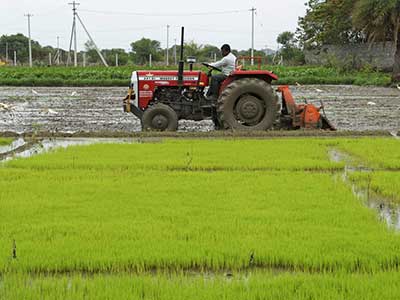Date: 30/03/2023
Relevance: GS-3: Transport and marketing of agricultural produce and issues and related constraints; e-technology in the aid of farmers.
Key Phrases: Sub-Mission on Agricultural Mechanisation, NCAER, Farm Machinery Industry, Small Farmers, Entrepreneurs, All-India Debt and Investment Survey, Harmonised Commodity Description, Imports.
Context:
- Despite the fact that the government has been implementing a Sub-Mission on Agricultural Mechanisation since 2014, there is no comprehensive record of how much farm machinery is being used by farmers.
Key Highlights:
- The NCAER White Paper titled 'Making India a Global Power House in the Farm Machinery Industry' reveals that the ownership of power farm equipment in India is not high.
- The paper suggests that the farm machinery industry in India is facing challenges related to both demand and supply.
- However, the quality of data stands out as a key challenge. The lack of a comprehensive database of farmers' usage of farm machinery poses a significant hurdle to the development of the sector.
Demand-side Challenges:
- One key demand-side challenge faced in the farm machinery
industry is the need for comprehensive data.
- In order to carry out robust analyses, there must be a clear understanding of how many farmers are using machinery, the types of equipment used, the ownership status of the equipment, and the impact farm machinery has on agricultural productivity.
- Additionally, it is necessary to know if farmers have become entrepreneurs by leasing equipment, what kind of equipment they are leasing, and whether they are experiencing any profitability.
- The All-India Debt and Investment Survey (AIDIS) provides
ownership data and reveals that the ownership of tractors among farmers is
only 4.4%, as of June 2018.
- On the other hand, only 5.3% of cultivator households own any one of the non-tractor farm equipment, which includes power tillers/power-driven ploughs, etc.
- Regarding rental data, the ‘Land and Livestock Holding of Households and Situation Assessment of Agricultural Households’ published by the MoSPI show that as of June 2018, 63.5% of agricultural households spent on hiring machinery and equipment for crop production.
- Despite the Sub-Mission on Agricultural Mechanisation (SMAM)
launched by the government since 2014, a comprehensive database of farmers’
usage of farm machinery is still lacking.
- Additionally, the surveys do not include the new crop-specific, operation-specific, and region-specific farm machinery that is now available.
Supply-side Challenges:
- The supply side of the farm machinery industry also faces several
challenges, and the lack of a dedicated National Industrial
Classification code for the industry is one of them.
- The industry has been mapped using the 7-digit product classification codes from the Annual Survey of Industries. However, relevant codes were clubbed together to form the industry since there is no dedicated code.
- Estimating the size of the sector, considering both the organised and
unorganised sector, requires approximations.
- Data show that the farm machinery sector is 0.6% of the overall manufacturing sector, with tractors alone accounting for 70% of that share.
- However, mapping the National Industrial Classification codes to Harmonised Commodity Description and Coding System codes is still a challenge, and sometimes the same HS code can be used for two products, which complicates the classification process.
- Estimating demand, domestic supply (from ASI product codes), and external supply (imports) is also problematic, since the codes used cannot be matched comprehensively. Therefore, matching the demand-supply remains an issue.
Consequences of Inadequate Data Quality:
- The lack of quality data hinders decision making and the implementation of appropriate policies in the farm machinery industry.
- Without a comprehensive understanding of the ownership of power
farm equipment, it is challenging to plan for the sector's growth and
development.
- The inadequate data quality also makes it difficult to match demand-supply and estimate domestic supply and external supply correctly.
- Furthermore, the data limitations make it challenging to include
the new types of farm equipment in the surveys, hindering the sector's
development.
- It is essential to capture crop-specific, operation-specific, and region-specific farm machinery data to meet the needs of farmers adequately.
Conclusion:
- The ownership of power farm equipment in India is still low, and the farm machinery industry faces significant demand and supply challenges.
- Improving the quality of data by expanding the scope of surveys and including new types of equipment is crucial to address these challenges effectively.
- The government must take further steps to encourage farmers to own or lease farm equipment to improve agricultural productivity and advance the development of the sector.
Source: The Hindu BL
Mains Question:
Q. Discuss the impact of the lack of a comprehensive database of farmers' usage of farm machinery on the development of the farm machinery industry in India. What measures can be taken to address this challenge? Discuss (250 words).







